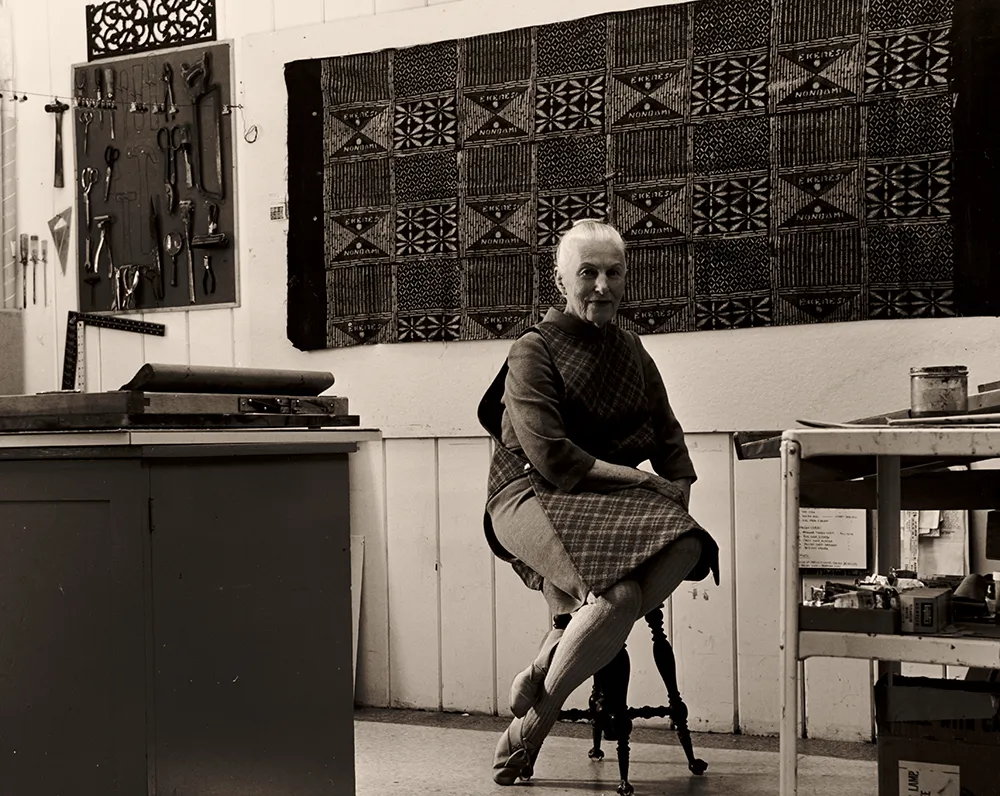Dorr Bothwell and Polynesian Patterns
/https://tf-cmsv2-smithsonianmag-media.s3.amazonaws.com/blogging/featured/AAA_bothdorr_25251_crop.jpg)
An intriguing portrait of artist Dorr Bothwell (1902–2000) in her studio captured my attention recently. I knew little of Bothwell’s life and work as a painter, printmaker, and art instructor. In Bill Foote’s black and white photograph, Bothwell exudes elegance as she sits perched on a stool, clothed in a plaid smock, smart wool dress, cable knit knights, and leather slippers. The pegboard of tools and silkscreen frame seems particularly evocative of her labor. Yet, the gridded rectangular wall hanging raised some questions for me: Where is it from? Did she make it? And, what significance did it hold for her to have such a place of prominence in her studio? Bothwell’s papers at the Archives of American Art provided some clues.
The wall hanging appears to be a siapo. Siapo is the Samoan name for Polynesian barkcloth, generally known as tapa. This piece likely dates from her period in Samoa. In 1928, she quit her job as a waitress when she inherited $3,000 from an aunt. Rather than buying things as others suggested, she packed a roll of canvas, stretchers bars, and paints and headed for Samoa. On May 3, 1928, Bothwell set sail for Pago Pago aboard the S.S. Sierra. In addition to her art supplies, she carried with her several letters of introduction from teachers and gallerists who attested to her success, hailing her as “a serious and recognized artist.” And, as her former teacher, Rudolph Schaeffer, professor of Rhythmo-Chromatic Design, explained, Bothwell possessed an interest in “studying the sources of underlying impulses producing individual expression of decorative design with various races in different lands.”

During her time in the Polynesian archipelago, Bothwell maintained a diary in which she recorded her daily activities: reading, swimming, gardening, and sketching. She studied local artistic traditions and made many studies of daily life in pen, pencil, and watercolor. According to an oral history conducted with Bothwell in 1986, she made a number of paintings that she shipped to her mother who took them to a gallerist in San Diego, CA. After that show sold-out, Bothwell sent over a second batch of materials that were exhibited in San Francisco, CA. She also completed seveteen measured drawings of tapa cloth that she sent to the Bishop Museum in Hawaii.
I have seen copies of Bothwell’s siapo from the period. She worked in colored pencil, principally in black, yellow, and red. The rhythmic patterns, with their stripes, triangles, squares, rectangles, and diamonds remind me of the exuberant Art Deco iconography that she would have been familiar with in the United States during the same period. And, it suggests the multiple sources of modern motifs and abstraction that she developed in her later paintings and serigraphs.
Shortly after she returned to the States, Bothwell presented a performance of her “tales of adventure in Samoa, illustrated with songs and dance” in 1930, in the Gold Ballroom at the Fairmont Hotel in San Francisco, CA. She later worked in the mural division of the Federal Arts Project of Los Angeles during the New Deal. During the rest of her life, she was a painter, printmaker, author, and art instructor in California and abroad. And, as this photograph suggests, Bothwell carried Polynesian patterns with her throughout her career.
This post originally appeard on the Archives of American Blog.
